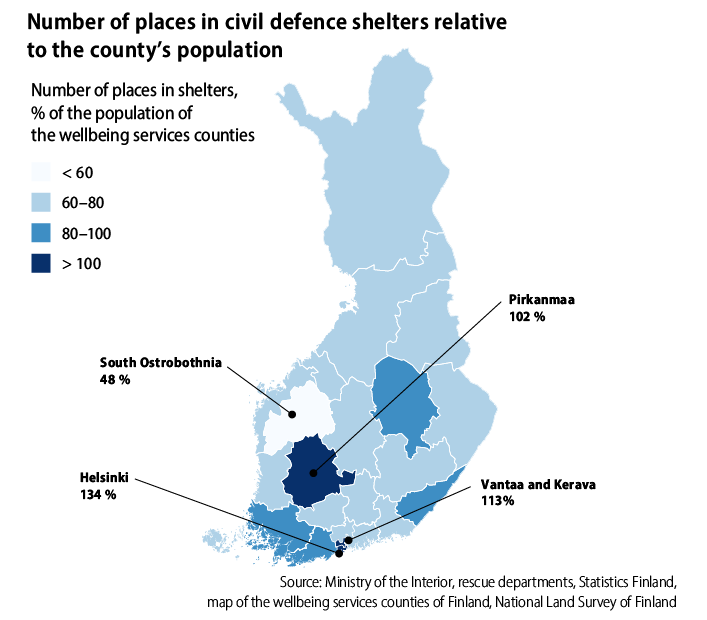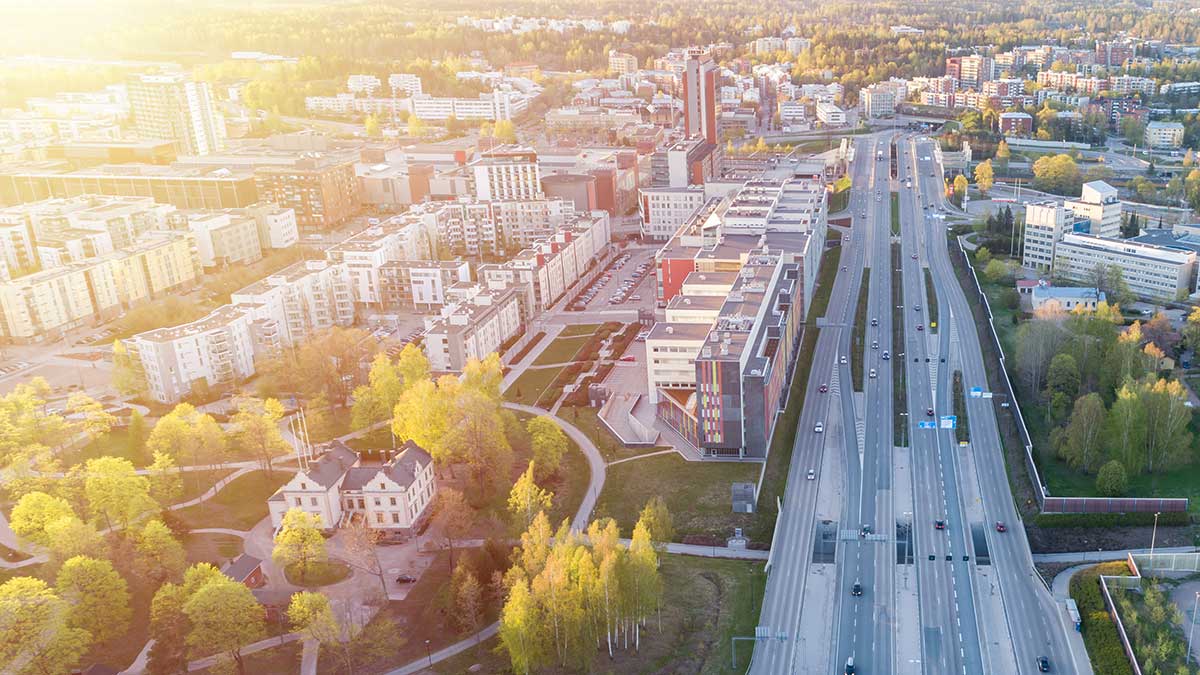
Ministry of the Interior’s report:
Finland has civil defence shelters for about 4.8 million people

Finland has around 50,500 civil defence shelters with space for about 4.8 million people. Finland has a sufficient number of places in shelters. Civil defence shelters are located in large cities in particular. The highest number of places in civil defence shelters in relation to the population can be found in the Greater Helsinki area and Pirkanmaa. This is evident in the preliminary data of the Ministry of the Interior’s report. The Ministry of the Interior is also examining the condition of civil defence shelters in Finland. The final report is expected to be completed in August. Finland is currently not facing a military threat.
When examined by wellbeing services county, the highest number of places in civil defence shelters is found in Helsinki, where the number of places is 34 per cent higher than the population. In relation to the population, the next highest number of places is found in the wellbeing services county of Vantaa and Kerava, where the number of places is 13 per cent higher than the population. In Pirkanmaa and West Uusimaa, the number of places in civil defence shelters is approximately the same as the number of residents.
By law, a civil defence shelter must be built in properties that exceed a certain size.
“Finland has enough places in civil defence shelters relative to the population. Shelters are concentrated in large cities, where people live more closely and buildings are larger. Therefore, the statutory obligation to build a civil defence shelter is more likely to be triggered in these cities,” says Project Manager Ira Pasi from the Ministry of the Interior.

In the majority of the current wellbeing services counties, there are places in civil defence shelters for 60–80 per cent of the population. South Ostrobothnia has the lowest number of places relative to the population with space for 48 per cent of the population.
“If a county mainly consists of small towns, it is more likely that it will also have fewer places in civil defence shelters. There are clearly more places in civil defence shelters in Seinäjoki than in other municipalities in South Ostrobothnia,” Pasi says.
Building stock and history partly explain regional differences
The number of civil defence shelters varies between municipalities even within the existing wellbeing services counties. This is mainly due to the building stock.
Large cities in the counties not only have apartment buildings but also commercial buildings, schools, recreational facilities and hospitals. People living in sparsely populated areas mainly live in single-family homes. In addition, there are fewer schools and other large buildings. This also applies to regions neighbouring large cities in southern Finland.
“Helsinki is a good example of how to protect people on the move. A lot of people from nearby areas take short visits to Helsinki for work and leisure. Therefore, there are many more places in civil defence shelters than there are people in the capital. Similarly, the increase in tourism in small towns, for example in Lapland, has increased the number of hotels and other large buildings, which has resulted in civil defence shelters being built in large buildings in these towns over the past few decades,” Pasi says.
The number of civil defence shelters in the counties is also affected by the history of so-called protected site municipalities. Earlier, the requirement to build shelters applied to these municipalities. These included large cities and transport hubs. Therefore, more civil defence shelters were also built in these areas. From 1991 onwards, the requirement to build shelters has been nationwide.
Previous estimate of the number of shelters and places has been revised
The previous estimate of the number of civil defence shelters was 54,000 with space for 4.4 million people. This estimate has now been revised so that there are slightly fewer civil defence shelters, but the shelters have more places in them.
The updated data on the number of shelters and places in shelters is based on data from rescue departments combined with previous data from the Ministry of the Interior and the construction and housing production data from Statistics Finland.
“Finland has a long tradition of building civil defence shelters. On the other hand, this decades-long history poses its own challenges for compiling precise register-based data. The authorities have had a number of different data collection systems, from which data has not always been transferred to other systems. There is variation in the data on older civil defence shelters, in particular,” Pasi says.
Civil defence shelters have been built in Finland in accordance with the legislation in force at the time, which means that shelters of different ages are slightly different. For example, shelters built according to the legislation in force before 1971 contain a sand filter and activated carbon filter or only a sand filter.
Civil defence shelters built after the legislation that entered into force in 1971 can be called modern shelters with modern ventilation systems and more equipment depending on the year of construction. About 85 per cent of civil defence shelters have been built after 1971.
Civil defence shelters are part of the range of tools for protecting the population
Civil defence measures would be activated if there would be a threat of war and during times of war. In such situations, the Emergency Powers Act would also be introduced. In emergency conditions, the population can be protected in many different ways. Key means of protecting the population include evacuations, i.e. moving people to a safer area, and providing shelter in civil defence shelters or temporarily built civil defence shelters.
“Finland is not currently facing a military threat. If civil defence shelters were taken into use, the need for protection would usually be at a local level. In addition, the number of people in different areas would change in emergency conditions. In circumstances when protection measures are needed, there would be fewer people in the areas than under normal conditions. Finland is a large country, and people could be transferred to other regions if necessary,” says Pasi.
Civil defence shelters are a valuable part of a property and need regular maintenance. They are often used as storage spaces or sports facilities.
“The maintenance of shelters is very easy and cheap, so it should not be neglected,” says Pasi.
Inquiries:
Ira Pasi, Project Manager, tel. +358 295 488 603, ira.pasi@gov.fi
The latest
 Press release
Press release
 Press release
Press release
 Press release
Press release
 Press release
Press release
 Press release
Press release


